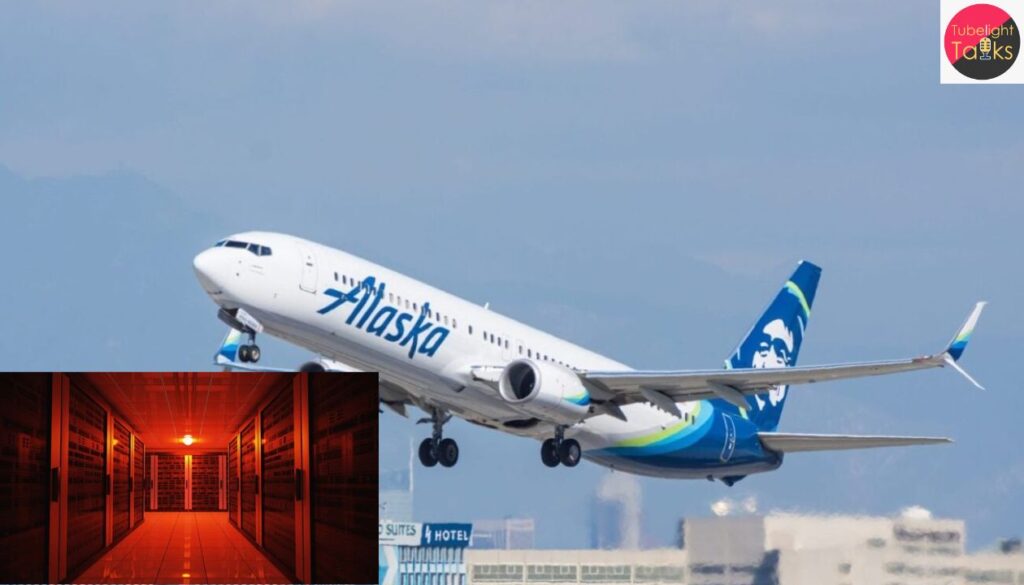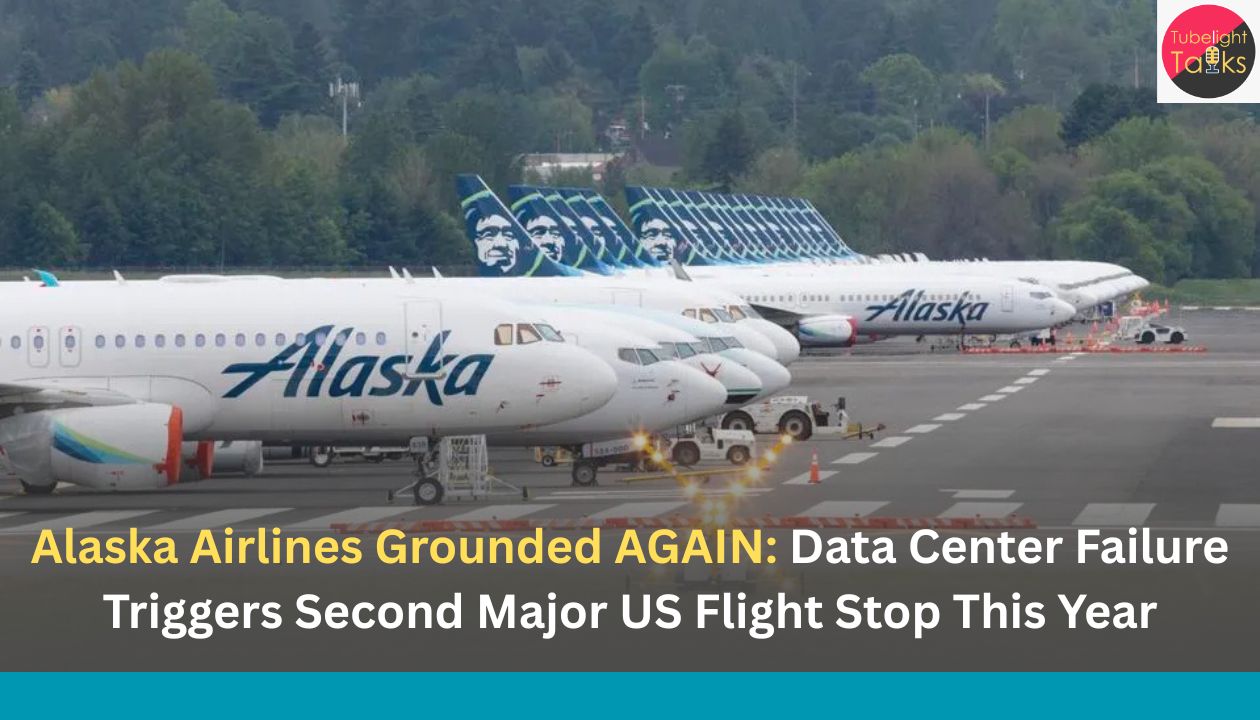Alaska Airlines grounded again, a major U.S. carrier, faced a massive operational crisis on Thursday as it was forced to implement a system-wide ground stop for all departing flights across its network in the United States. The cause: an unspecified, yet catastrophic, Information Technology (IT) outage that crippled core systems essential for managing flight operations. This immediate halt, mandated for the safety and stability of the network, also impacted flights operated by the airline’s regional subsidiary, Horizon Air, creating an instant ripple effect of chaos for thousands of travelers.
The Federal Aviation Administration (FAA) issued an advisory confirming the temporary ground stop, underscoring the severity of the technical breakdown. The Seattle-based airline quickly took to social media platform X (formerly Twitter), confirming the disruption and offering a curt apology: “Alaska Airlines is experiencing an IT outage affecting operations. A temporary ground stop is in place. We apologize for the inconvenience.”
This latest incident isn’t just an isolated hiccup; it serves as a glaring and deeply concerning reminder of the fragile state of digital infrastructure in the modern aviation sector. It marks the second time this year that a major IT failure has brought the airline to a grinding standstill, demanding urgent attention from both the carrier’s leadership and regulatory bodies.
The Anatomy of a Failure: A Troubling Precedent
While the immediate impact was evident in packed terminals and long delays, the underlying technical cause points to a vulnerability deep within the airline’s operational core.

The airline later released an official statement clarifying the source of the outage: the issue originated from a failure at the company’s primary data center. This failure compromised several of the carrier’s key systems used for critical operations such as check-in, scheduling, departure control, and communications, necessitating the implementation of the ground stop to keep aircraft safely positioned.
Echoes of July: The Recurring Hardware Crisis
The parallels to the airline’s previous 2024 failure are stark and raise serious questions about system redundancy and resilience. Just three monthshttps://x.com/AlaskaAirNews/status/1981622927515603139 prior, in July, Alaska Airlines grounded all flights for approximately three hours due to the failure of a critical piece of multi-redundant hardware at one of its data centers. That disruption similarly affected both Alaska and Horizon flights, resulting in a cascade of over 150 cancellations and significant customer disruption.
The recurrence of a core infrastructure failure originating from the data center—first a critical hardware component, and now a failure at the primary center itself—suggests that post-July recovery measures may have been insufficient or that the underlying architectural fragility of the core system persists. The severity of a system-wide shutdown from a single internal component failure underscores the urgent need for a more robust and decentralized IT framework. Crucially, the airline has consistently maintained that neither the July nor the October outage was a cybersecurity event, attributing the problems squarely to internal technical deficiencies.
Also Read: ‘MayDay’ Declared by United Airlines Heading Munich From Washington
The Traveler’s Plight: A Human Cost of Technical Glitches
For the traveling public, a system-wide ground stop translates into more than just numbers—it’s a disruption to life, from missed connections and canceled vacations to critical business meetings put on hold. The outage, which began mid-afternoon, immediately impacted operations at major hubs, particularly along the U.S. West Coast where Alaska Airlines is dominant, including Seattle-Tacoma (SeaTac), Portland International (PDX), and major California airports. The initial ground stop was requested to last approximately 70 minutes, but the cascading effects of repositioning aircraft and crews meant the disruption persisted for several hours, leading to scores of flight cancellations and further delays well into the next day.
The immediate reaction on social media from stranded passengers was one of frustration, compounded by the airline’s initial generic responses. A lack of real-time, actionable information at the gates often leaves travelers feeling helpless. This “human touch” element is a critical component of every airline failure, where technology’s lapse immediately tests customer service and communication efforts. As one frustrated traveler posted, reflecting the anxiety of being stuck during a sudden operational collapse, there were “No boarding, no firm updates,” despite packed waiting rooms.
Unaffected Subsidiary Highlights Network Separation
Despite being part of the larger Alaska Air Group, Hawaiian Airlines confirmed that its operations remained completely unaffected by the ground stop. This separation is a small piece of good news, demonstrating that their acquired subsidiary’s system operates independently, preventing a full, group-wide crisis and confirming the localized nature of the core IT failure.
Wider Industry Instability: The Fragile Digital Backbone
Alaska’s recurring issue underscores a persistent, industry-wide challenge: the vulnerability of the aviation sector’s legacy IT systems. Airlines rely on an incredibly complex and interconnected stack of technology—from Passenger Service Systems (PSS) to crew and maintenance scheduling and departure control platforms. A single point of failure deep within this stack, such as data center hardware, can rapidly propagate and bring operations to a halt, even if the physical aircraft and crews are ready to go.
In recent months, technical issues have plagued other major carriers globally, demonstrating that IT vulnerability is a systemic problem, not just an isolated one for Alaska. Notable disruptions include:
- United Airlines: Faced a temporary ground stop at multiple US airports this year due to a separate, internal technology platform issue.
- Air India: Scheduled an additional flight to retrieve passengers stranded overseas following a technical cancellation, highlighting similar global issues with operational resilience.
Experts often point to the heavy reliance on legacy monolithic architectures and insufficient investment in modernization and true multi-layered redundancy as the root cause. As a leading analyst on aviation IT resilience noted, “The industry has poured billions into customer-facing digital tools, yet the technical debt in foundational operational systems persists. Until airlines ensure their digital backbone is hardened, passengers should expect this pattern to repeat.” The industry-wide challenge of strained air traffic control and weather-related delays, exacerbated by the recent government shutdown, only adds further pressure, making IT stability more critical than ever.
Forward Outlook: Navigating the Recovery and Rebuilding Trust
Following the lifting of the ground stop, Alaska Airlines is now engaged in the complex, labor-intensive process of network recovery. This involves manually resolving the system backlog, repositioning hundreds of aircraft, and ensuring crews comply with strict duty-time limits. The airline has confirmed over 200 flight cancellations and warned that additional flight disruptions are likely to continue as it works to stabilize its network. To support affected guests, Alaska has implemented a flexible travel policy, allowing passengers with impacted Thursday or Friday flights to change or cancel their bookings without penalty.
Beyond the immediate operational challenge, this incident places renewed pressure on Alaska Airlines’ executive team to demonstrate that their IT infrastructure is fit for purpose. Frequent, costly, and high-impact failures erode customer confidence and carry significant financial implications, including compensation costs and lost revenue. For an industry where safety and reliability are paramount, technology must be a foundation of strength, not a point of recurring weakness.
A Spiritual Perspective: Safety in the Unique Knowledge of Saint Rampal Ji Maharaj
Unpredictable emergencies, like this technical failure, emphasize the harsh reality of life’s uncertainty and the inevitability of death. Jagatguru Tatvdarshi Sant Rampal Ji Maharaj teaches that the only path to permanent safety and eternal life is through the refuge of the Supreme God Kabir, obtained by following the authentic method of worship found in our Holy Scriptures. This practice can both safeguard one’s life in this world (as evidenced in the RigVeda) and end the cycle of birth and death forever, leading the soul to the everlasting abode, Satlok. For authentic spiritual insights, visit www.jagatgururampalji.org or watch the ‘Sant Rampal Ji Maharaj’ YouTube channel.
The Critical Need for Digital Resilience in Aviation
The repeated, system-wide operational failures at Alaska Airlines—specifically linked to fundamental data center issues—serve as a sharp industry warning about the dangers of inadequate digital resilience. Despite rapid digital transformation in customer experience, the core, interconnected operational systems of many airlines remain vulnerable to single points of failure, leading to costly and chaotic ground stops that impact thousands of travelers. To safeguard their reputation and future profitability, the airline and the broader sector must prioritize massive, non-negotiable investments in robust, decoupled, and truly redundant technology architecture to ensure safe, stable, and predictable air travel for passengers.
FAQs on Alaska Airlines IT Outage
What caused the nationwide grounding of Alaska Airlines flights?
A major IT outage resulting from a failure at the airline’s primary data center.
Was this the only IT failure the airline faced this year?
No, it’s the second major outage. A similar three-hour grounding occurred in July.
Which airlines were affected by this specific ground stop?
Alaska Airlines and its regional partner, Horizon Air.
Was this system failure caused by a cyberattack?
No, the airline confirmed it was a technical, internal hardware failure, not a cybersecurity event.
Did the disruption affect Hawaiian Airlines?
No, Hawaiian Airlines confirmed its flights were not impacted by the outage.










